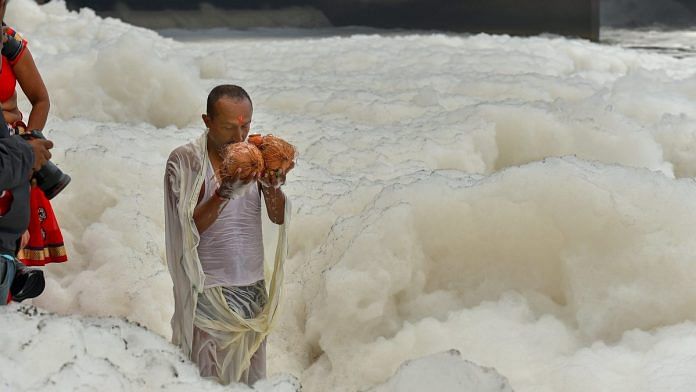New Delhi: As many as 100 out of the 150 drains in the catchment area of Yamuna river do not meet the general standards for discharge of environmental pollutants, the central environment ministry has told the Supreme Court.
In a joint affidavit filed before the top court Wednesday, the Ministry of Environment, Forest and Climate Change and the Central Pollution Control Board (CPCB) gave state-wise and flow-wise details of the drains. According to the affidavit, 50 per cent of the polluting drains fall in Uttar Pradesh.
CPCB had sought data from the state pollution control boards of Uttarakhand, Himachal Pradesh, Haryana, Uttar Pradesh and Delhi to prepare a consolidated chart on pollution levels in Yamuna, following an order by the top court that is hearing a plea on “remediation of polluted rivers” in the country.
The affidavit also pointed out that at various places across the five states dissolved oxygen, essential for aquatic life, ranged from below detection levels to 5.6 mg/litre, as against the standard of above 5 mg/litre.
While the assessment of water quality found no gap in treatment and disposal of hazardous waste as well as industrial wastewater management, it identified gaps in sewage generation and treatment capacity in 60 cities as well as municipalities, including Delhi.
According to the affidavit, Delhi and Haryana governments should execute approved action plans by 30 June 2021, under overall supervision and coordination of the principal environment secretary of the states concerned for Yamuna rejuvenation.
Also read: NGT-constituted panel pulls up Delhi Jal Board for inefficiency in reducing Yamuna pollution
‘Water released by Haryana has high ammonia content’
A bench, led by Chief Justice of India S.A. Bobde, took suo motu cognisance of pollution in the Yamuna after the Delhi Jal Board (DJB) alleged that water containing high pollutants was being released into the river in Haryana.
The DJB claimed that the water released by Haryana authorities has high ammonia content, which becomes carcinogenic after mixing with chlorine. It sought a direction to the Haryana government to ensure that pollutant-free water was released into the river.
Hearing the plea, the bench said it will initiate a legal process against pollution of water bodies by untreated sewage, and registered a suo motu writ petition in the matter.
Notices were issued to Uttarakhand, Himachal Pradesh, Haryana, Delhi and Uttar Pradesh as well as the secretaries of the Ministry of Environment, Forest and Climate Change and the Ministry of Housing and Urban Affairs, and the CPCB.
The pollution control board was told to identify municipalities along the river that have not installed total treatment plants for sewage, according to the requirements, or have gaps in ensuring that no untreated sewage was discharged into the river.
Three polluted stretches in river Yamuna
The central government’s affidavit noted: “Water quality data of drains depict that 100 drains in the catchment of river Yamuna (2 in Himachal Pradesh, 52 in Uttar Pradesh, 20 in Delhi, 26 in Haryana) are not meeting general standards for discharge of environment pollutants in respect of one or more parameters namely; BOD (biochemical oxygen demand), COD (chemical oxygen demand) and TSS (total suspended solids).”
Data also revealed that a total of 156 drains open into the Yamuna from 70 municipalities. Gaps between sewage generation and treatment was found in as many as 60 cities along the river.
As an example, the ministry cited the case of Delhi where sewage generation stands at 3,273 MLD (million litres per day) and total installed operational capacity of 35 treatment plants is 2,715 MLD. However, actual utilisation is only 2,432 MLD, of which only 711 MLD complies with discharge norms.
Therefore, in Delhi, the affidavit added, the gap in sewage treatment is 2,562 MLD.
In some cities, while gaps with respect to sewage treatment were identified, water quality of the river met the primary criteria for bathing, the ministry said. These cities are Vikas Nagar and Harbatpur in Dehradun, Purola in Uttarkashi and Ponta Sahib in Himachal Pradesh.
Based on the data, CPCB has identified three polluted stretches of the Yamuna — Panipat to Sonepat in Haryana, Wazirabad in Delhi to Asgarpur in Haryana and Asgarpur to Etawah in UP.
According to reports received from the state pollution control boards, 100 per cent hazardous and industrial waste generated in the three polluted stretches of the river was being treated and processed following applicable rules. However, the ministry said that looking at the water quality in various drains being discharged into Yamuna, the claim by these states appear to be on “higher side”.
Also read: Najafgarh jheel to nala — How Delhi and Gurugram ruined their second-largest waterbody



